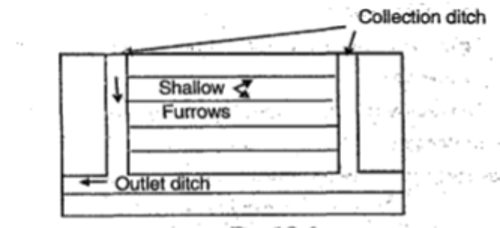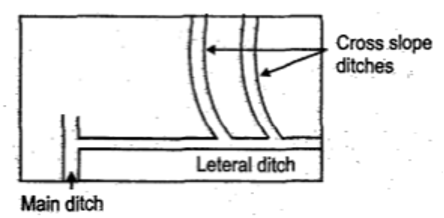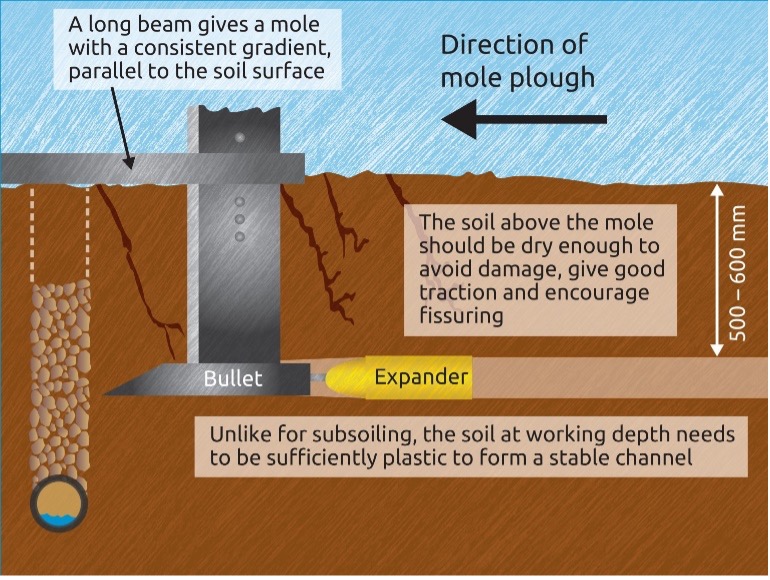🧊 Agricultural Drainage
Learn about Surface and Sub-surface Drainage.
Agricultural Drainage
- Agricultural drainage is the removal of excess water known as free water or gravitational water from the surface or below the surface of farm land so as to create favourable soil conditions for plant growth.
Waterlogging
- A land is called water logged when water stagnates or flow over the soil surface.
Causes of Waterlogging
- (a) Natural
- (i) Poor natural drainage of subsoil.
- (ii) Submergence under floods.
- (b) Artificial
- (i) High intensity of irrigated agriculture irrespective of the soil and subsoil.
- (ii) Heavy seepage losses from unlined canals, distribution and farm water courses.
- (iii) Enclosing irrigated fields with embankments and chocking up natural drainage.
- (iv) Hydraulic pressures from upper saturated areas at higher elevations.
- (v) Non-maintenance of natural drainage or blocking of natural drainage
Effects of Poor Drainage
- Causes relatively poor root growth.
- Accumulation of excess soluble salts in shallow water table.
- Reduction of soil strength.
- Oxygen diffusion is 10,000 times lesser than running water.
- Redox potential is
–400 mV. - Accumulation of CO2, CH4, HCO3-, CO32- and H2S.
- Change in the pH and natural stabilization.
- Anaerobic microbes exits with low energy level.
- Reduced nutrient availability.
- Accumulation of toxicants (H2S, CH4).
- Poor crop growth/nutritional disorders and yield reduction.
- Can impair the N-nutrition of legumes by interfering with nodulation.
- Waterlogging injury caused primarily Mn toxicity occurs in plant species with low inherent. Mn tolerance e.g. Lucerne.
Drainage coefficient (DC) is defined as the depth of water (cm) to be drained in 24 hours period from the entire drainage area. Drainage of one ha-cm (105 lt) in 24 hrs equals drainage of 1.157 litre per second (lps). Drainage coefficient helps to determine drainage depth (drainage size). For open ditches in small areas, DC ranges from 0.6 to 2.5 cm.
Methods of Drainage
1) Surface Drainage
Simplest and most common in India by digging open drainage at suitable intervals and depth.
✅ Advantages
- Cheap
- Defects in the open drainage can be seen easily and rectified
- Requires less available fall or grade for adequate outlet
❌ Disadvantages
- Some land is wasted for open drains
- Causes hindrance to field preparation and intercultivation.
- Periodical de-silting is necessary.
- Heavy weed growth.
- It may be damaged by rodents and farm animals.
There are several methods and systems for surface drainage having three functional parts viz. Collection, Disposal and Outlet systems.
(a) Drainage of flat areas**
Slope less than 2%- For flat areas, two processes are adopted:
- Smoothing/grading/forming means land with continuous slope i.e. elevated areas are cut off and excess soil is spread over lower areas so that surface becomes even with uniform slope. Excess run off is collected and conveyed into the field ditches.
- Field ditches system: (a) Bedding system: Small furrows are formed at known intervals parallel to the slope for draining out water. Those furrows are called dead furrows and land between these furrows are called beds.

(b) Parallel field ditch: Similar to bedding system except for deep drains and uneven interval between drains. Most effective and suited for both irrigated & rainfed.

(c) Parallel, open field ditch: Deeper in depth, and steeper side slopes than parallel field ditch hence is the name, ‘open’ also called diversion ditch system; It is used in both surface and sub-surface drain.

(d) Broad Bed and Furrow system (BBF): Field is laid out into 120-150 cm width beds and 45 cm wide furrows across the slope. About 0.5 % slope is provided for free drainage. Crops are sown on beds having two or more than two rows each. Beds are 15 cm raised. BBF method is widely practiced in groundnut in clay soil.

(b) Drainage of Ponded Areas
- Micro ponds or depressions are connected by means of shallow channels or ditches. Drainage of water is made by random field ditch system.

(c) Drainage of sloping areas
Slope > 2 %- By interception system or cross slope ditch system.

The flow rate from soil to drains depends on:
- Hydraulic conductivity of the soil (HC)
- Depth of the drains
- Horizontal spacing between drains
2) Sub-surface Drainage
Purpose is to lower down the ground water level below root zone. These are the following methods:
A) Tile drains
- < 2 per cent slope, it includes perforated pipes. lt has following types of arrangements of tiles or pipes. Minimum recommended size of tile is 10 to 15 cm.
(i) Natural or Random

(ii) Gridiron system
- Tiles arrangements from
one sideonly.
(iii) Herringbone system:
- Laterals are provided only on
both sideof mains.
(iv) Double main system
(v) Cut off or intercepter
- It intercepts seepage moving down a slope. The interceptors should be usually placed at about the upper boundary of the wet area.
- Adopted when main source of drainage is from a hilly land.
B) Mole drains A mole is the egg- shaped drain which is made in the clay soil with the help of Mole plough. Once made mole drain remains functional for 3-5 years and especially suitable for clay soils.

C) Vertical drainage Drainage by wells is called vertical drainage. Wells are digged out to collect water from the nearby areas through seepage and collected water is pumped out.
D) Deep open drainage Deep open drains are made in which water is collected by seepage which drained out from the field.
E) Burried drainage Draining channel is made below the ground surface. After making it drains are filled with tiles, fibres or plastics.
F) Combination of tile and open drains.
Agricultural Drainage
- Agricultural drainage is the removal of excess water known as free water or gravitational water from the surface or below the surface of farm land so as to create favourable soil conditions for plant growth.
Waterlogging
- A land is called water logged when water stagnates or flow over the soil surface.
Causes of Waterlogging
- (a) Natural
- (i) Poor natural drainage of subsoil.
- (ii) Submergence under floods.
- (b) Artificial
- (i) High intensity of irrigated agriculture irrespective of the soil and subsoil.
- (ii) Heavy seepage losses from unlined canals, distribution and farm water courses.
- (iii) Enclosing irrigated fields with embankments and chocking up natural drainage.
- (iv) Hydraulic pressures from upper saturated areas at higher elevations.
- (v) Non-maintenance of …
Become Successful With AgriDots
Learn the essential skills for getting a seat in the Exam with
🦄 You are a pro member!
Only use this page if purchasing a gift or enterprise account
Plan
- Unlimited access to PRO courses
- Quizzes with hand-picked meme prizes
- Invite to private Discord chat
- Free Sticker emailed
Lifetime
- All PRO-tier benefits
- Single payment, lifetime access
- 4,200 bonus xp points
- Next Level
T-shirt shipped worldwide

Yo! You just found a 20% discount using 👉 EASTEREGG

High-quality fitted cotton shirt produced by Next Level Apparel